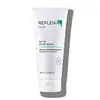What's inside
What's inside
 Key Ingredients
Key Ingredients

 Benefits
Benefits

 Concerns
Concerns

 Ingredients Side-by-side
Ingredients Side-by-side

Water
Skin ConditioningButylene Glycol
HumectantSodium Stearate
CleansingBis-PEG-18 Methyl Ether Dimethyl Silane
EmollientGlycerin
HumectantSodium C16 Olefin Sulfonate
EmulsifyingLavandula Angustifolia Flower Water
Skin ConditioningCocamidopropyl Betaine
CleansingQuaternium-90 Sepiolite
Emulsion StabilisingStearic Acid
CleansingPhenoxyethanol
PreservativeSodium Polyacrylate
AbsorbentLactobacillus
Skin ConditioningCamellia Sinensis Leaf Powder
ExfoliatingAlgae Extract
EmollientMacrocystis Pyrifera Extract
Skin ConditioningQuaternium-90 Montmorillonite
EmulsifyingChlorphenesin
AntimicrobialParfum
MaskingCI 19140
Cosmetic ColorantCI 42053
Cosmetic ColorantWater, Butylene Glycol, Sodium Stearate, Bis-PEG-18 Methyl Ether Dimethyl Silane, Glycerin, Sodium C16 Olefin Sulfonate, Lavandula Angustifolia Flower Water, Cocamidopropyl Betaine, Quaternium-90 Sepiolite, Stearic Acid, Phenoxyethanol, Sodium Polyacrylate, Lactobacillus, Camellia Sinensis Leaf Powder, Algae Extract, Macrocystis Pyrifera Extract, Quaternium-90 Montmorillonite, Chlorphenesin, Parfum, CI 19140, CI 42053
Ingredients Explained
These ingredients are found in both products.
Ingredients higher up in an ingredient list are typically present in a larger amount.
Phenoxyethanol is a preservative that has germicide, antimicrobial, and aromatic properties. Studies show that phenoxyethanol can prevent microbial growth. By itself, it has a scent that is similar to that of a rose.
It's often used in formulations along with Caprylyl Glycol to preserve the shelf life of products.
Stearic Acid is a fatty acid. It is an emollient, emulsifier, and texture enhancer.
As an emollient, stearic acid helps soften skin. It aids the skin's protective barrier by preventing water loss. It also provides a gentle cleansing effect without stripping away natural oils.
Stearic acid may also be used to enhance the texture of products. It can add volume and stabilize ingredients such as water and oil. This can help water and oil ingredients from separating.
Sources of stearic acid include animal or vegetable fats/oils such as coconut or shea. It can be naturally found in butter, cocoa butter, shea butter, vegetable fats, and animal tallow.
This ingredient may not be Malassezia folliculitis, or fungal-acne safe.
Learn more about Stearic AcidWater. It's the most common cosmetic ingredient of all. You'll usually see it at the top of ingredient lists, meaning that it makes up the largest part of the product.
So why is it so popular? Water most often acts as a solvent - this means that it helps dissolve other ingredients into the formulation.
You'll also recognize water as that liquid we all need to stay alive. If you see this, drink a glass of water. Stay hydrated!
Learn more about Water